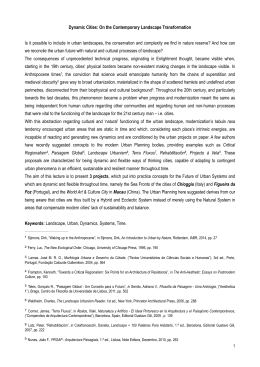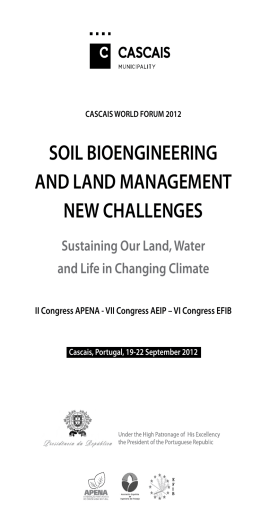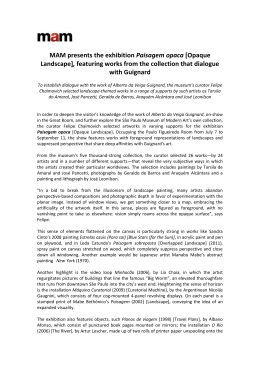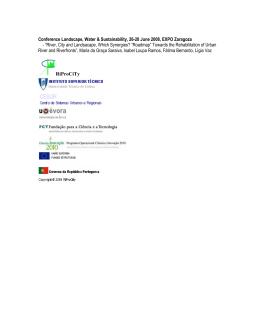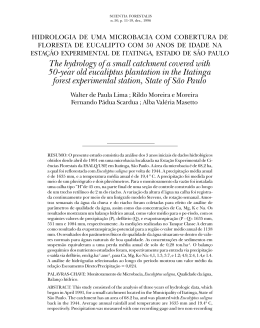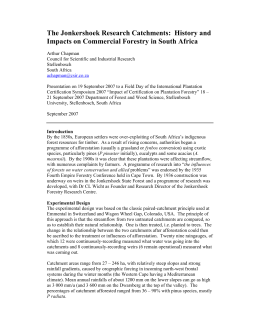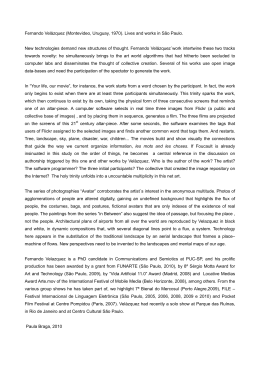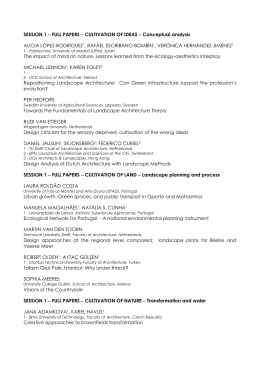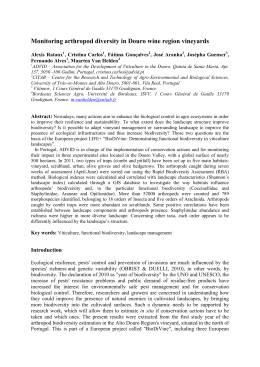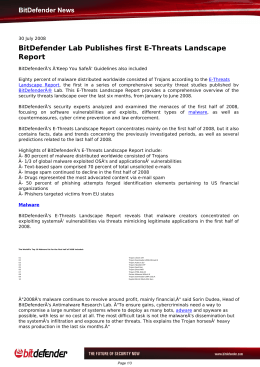PII: S0043-1354(01)00062-8 Wat. Res. Vol. 35, No. 14, pp. 3462–3472, 2001 # 2001 Elsevier Science Ltd. All rights reserved Printed in Great Britain 0043-1354/01/$ - see front matter BUFFER ZONE VERSUS WHOLE CATCHMENT APPROACHES TO STUDYING LAND USE IMPACT ON RIVER WATER QUALITY LUCIE SLIVA* and D. DUDLEY WILLIAMS Division of Life Sciences, University of Toronto at Scarborough, 1265 Military Trail, Scarborough, Ontario MIC 1A4, Canada (First received 1 July 2000; accepted in revised form 1 January 2001) Abstract}Secondary databases, GIS and multivariate analysis tools were used to determine whether there was a correlation between water quality and landscape characteristics within three local southern Ontario watersheds. Whole catchment and 100 m buffer zone influences on water quality over three seasons were compared. Chemical fluxes were also calculated and used to compare the loading of pollutants to downstream environments. Urban land use had the greatest influence on water quality. The influence of agricultural land use was variable and did not agree with the results of other studies. The only natural landscape variables that appeared to have an influence on water quality were slope and silt–clay surficial geology deposit. There was a clear trend of increased chemical fluxes with increasing urban land use intensity within a watershed. Forested land use appeared important in mitigating water quality degradation. The catchment landscape characteristics appeared to have slightly greater influence on water quality than the 100 m buffer. The results of this study may have been influenced by the scale and accuracy of databases used. The secondary data were useful in determining major trends in water quality and possible non-point origins of surface water pollution, and in identifying areas that are in need of further investigation. # 2001 Elsevier Science Ltd. All rights reserved Key words}water quality, land use, non-point pollution, secondary data analysis INTRODUCTION Surface waters can be contaminated by human activities in two ways: (1) by point sources, such as sewage treatment discharge and storm-water runoff; and (2) by non-point sources such as runoff from urban and agricultural areas. Non-point sources are especially difficult to detect since they generally encompass large areas in drainage basins and involve complex biotic and abiotic interactions (Solbe, 1986). Natural catchment characteristics such as topography and surficial geology can influence surface water quality also. For example, the biochemical processes in the terrestrial environment dominate the hydrochemical response of small catchments, because stream water is largely made up of drainage from soils (Moldan and Cerny, 1994). Despite their importance, the influences of natural landscape variables are not usually included in watershed management studies because they considerably complicate the analysis. Watershed management and catchment scale studies have become increasingly more important in *Author to whom all correspondence should be addressed. Fax: +1-416-287-7423; e-mail: [email protected] determining the impact of human development on water quality both within the watershed as well as that of the receiving waters. Although these studies have become more common in the past 20 years, they still leave many questions unanswered. For example, there is still an ongoing dispute regarding whether the land use of the entire catchment or that of the riparian zone is more important in influencing the water quality, all other factors remaining constant (Osborne and Wiley, 1988; Delong and Brusven, 1991; Johnson et al., 1997). These uncertainties remain partly because each catchment has a unique combination of characteristics that influence water quality, and partly because thorough investigations at the watershed scale are extremely time and resource consuming. Effective analytical tools, such as geographical information systems (GIS) and multivariate statistics, are able to deal with spatial data and complex interactions, and are coming into common usage in watershed management (Richards and Host, 1994; Xiang, 1995; Allan and Johnson, 1997; Johnson and Gage, 1997; Cao et al., 1999). However, their effectiveness depends on the quality and quantity of data collected in the field, which tend to be sparse, especially when dealing with entire watersheds. One 3462 Land use impact on river water quality method of analyzing the interaction between a watershed and its water quality is to look at existing databases, generated by local and regional governments for monitoring purposes. These databases may be useful in gaining an initial understanding of the processes and interactions that might be occurring within a watershed and may give direction to more detailed research and management objectives. This study investigates the benefits and limitations of using such secondary data in determining the magnitude of human impacts on freshwater environments. The two databases (water quality and discharge) used were provided by the Ontario Ministry of Environment and the Water Survey Division of Environment Canada. Besides having a basic monitoring objective, the bulk of these databases was generated without an extensive study purpose in mind and thus they may be limited in their spatial and temporal resolution. Usually, the sampling schedule is rigidly set, regardless of the irregular nature of environmental phenomena. Despite these shortcomings, the use of readily available databases is very attractive because a considerable investment 3463 in time and resources has to be devoted to sampling, especially in large watershed-scale projects, in order to obtain results that reasonably reflect reality. The objectives of this study were therefore threefold: (1) to investigate the benefits and limitations of using governmental water quality monitoring databases; (2) to determine the effects of human (land use) and natural (topographic and geologic) landscape influences on water quality in three local rivers; and (3) to compare the influences of a 100 m buffer zone and whole catchment landscape characteristics on water quality. SITE DESCRIPTION The three watersheds in the study area are located adjacent to each other on the east side of the Greater Toronto Area (GTA), Ontario, Canada (Fig. 1). All of the constituent rivers flow into Lake Ontario. The Highland Creek watershed is the smallest and the most urbanized (10,168 ha); the Rouge River watershed is moderately urbanized covering the largest Fig. 1. Location of study area showing the location of the Ontario Ministry of Environment water quality sampling stations and Environment Canada discharge stations in Highland Creek, Rouge River and Duffins Creek. 3464 Lucie Sliva and D. Dudley Williams area (33,288 ha); and the Duffins Creek watershed is the least urbanized, and 28,653 ha in size. The surficial geology of the area is a direct result of Pleistocene glaciations, which left behind a mixture of glaciolacustrine beach deposits, glaciolacustrine deposits, Halton and Northern tills, and the deposits of the Oak Ridges Moraine (Eyles and Clinton, 1998). geology layer was subdivided into four categories: (1) sand–gravel–silt deposits (alluvial stream deposits, Oak Ridges ice contact deposit); (2) sand deposits (Lake Iroquois shallow water deposits and Peel Ponds shallow water deposits); (3) silt–clay deposits (Lake Iroquois deep water deposits, Peel Ponds deep water deposits and Middle Wisconsinan and older tills); and (4) silty-sand till deposits (Late Wisconsinan Halton Till; Eyles and Boyce, 1991). GIS analysis METHODS Data sets Water quality data were obtained from the Ontario Ministry of the Environment, which takes monthly samples of surface water and analyzes them using standard methods (OME, 1994). Twelve water quality stations (Fig. 1) were chosen because they had complete water quality sampling records for the entire study period: 1990–1993, the longest possible intact water quality record span. Dissolved oxygen (DO), temperature, alkalinity, faecal coliform count, ammonium (NH4), nitrate (NO3), phosphate (PO4), total solids (TS), copper (Cu), and chloride (Cl) were chosen to represent the state of surface water quality. These variables were averaged over three time periods: spring (January–April), summer (May–August) and fall (September–December). The three time periods were chosen based on the characteristic river discharge patterns as well as on the region’s growing season. The average discharge regime for the three rivers was highest in the spring and lowest in the summer. Spring discharge was significantly greater than summer and fall discharge (T-test, p50:001). Although the average summer and fall discharges were not significantly different, the two seasons were treated separately because the reduction in interception capacity of the region’s vegetation during fall and winter may have an influence over chemical loading to the watersheds. The winter period was divided between spring and fall because field sampling by the OME during that time was not as regular as the rest of the year. The mean seasonal water quality was averaged over a four-year period (1990–1993) to reduce the effects of possible field sampling and laboratory analysis errors and any missing values. For each of the major watersheds (sub-watersheds 1, 3 and 12), fluxes were calculated using concentrations of the chemicals and discharge to determine the amount of pollution that was transported downstream. The Water Survey Division of Environment Canada provided the discharge data. These data matched locations for three OME water quality stations within the study area (Fig. 1). A two-year period (1990–1991) was chosen for the analysis of chemical loading, because continuous discharge measurements for all three streams were available only for this time period. The discharge data were used to calculate average monthly and yearly specific fluxes for six water quality parameters (NH4, NO3, PO4, TS, Cu and Cl) by multiplying the discharge by chemical concentrations and dividing them by the catchment area. Digitized land use maps were obtained from the Metropolitan Toronto and Region Conservation Authority (MTRCA) at a scale of 1 : 50,000, and from Meriano (1992) at a scale of 1 : 100,000. A surficial geology map (representing soils) was obtained from Westgate (1971), and a digital elevation model (DEM), developed for the GTA, was provided by the Ontario Ministry of Natural Resources and Canadian Hydrographic Service (1999). The land use for each watershed was subdivided into four categories: (1) field, including pasture lands, and golf courses; (2) forested land; (3) agricultural land, including row and non-row crop agriculture; and (4) urbanized land, including industrial and residential areas. The surficial ArcView (ESRI, 1996), a vector-based GIS software package, was used to determine the composition of the land use and surficial geology characteristics within the three watersheds. Surface elevation and the standard deviation of slope were derived from the DEM. The standard deviation of slope was used, as opposed to average slope, because of the relatively flat terrain present in Southern Ontario, with only a few areas of large elevation changes generally located around the southern portion of the river catchments. For each water sampling station, watershed and sub-watershed boundaries were delineated with ArcView’s spatial analyst (ESRI, 1996) using the DEM data. The land use and surficial geology percent compositions, along with the watershed area and standard deviation of slope, were determined for each of the sub-watersheds using the tools provided by the GIS software. All databases were transformed into a common digital format, projected onto a common coordinate system (UTM) and analyzed in ArcView as vectors. For each of the sub-watersheds, ArcView’s buffer facility was used to extract landscape data for the area 100 m, the smallest unit determined by the lowest resolution of the digitized landscape data, on each side of the river. This procedure allowed a comparison of the influence of landscape data on water chemistry within the 100 m buffer area with that of the landscape data derived for the whole catchment. Statistical analysis Identical statistical analyses were performed on data both from the buffer zone and the entire catchment to determine relationships between the landscape variables and water quality. The Kolmogorov–Smirnov goodness of fit test was used to test for normality of distribution of the individual water quality and landscape variables. The Kruskal–Wallis test was used to determine whether there was a significant difference between seasonal concentrations within the 12 sub-watersheds. The predictors (landscape data) and the response variables (water quality) were transformed with either a power or logarithmic function, to make the data normally distributed and to reduce the influence of outliers. Water quality–landscape interactions were explored using multiple regression and redundancy analysis (RDA). Multiple regression (MathSoft, 1998) was used to determine whether landscape factors have positive or negative influence on separate water quality variables and how strong this interaction is using six predictor variables (agricultural, forested, urban and field land-use variables; and standard deviation of slope and silt–clay deposit natural landscape variables). RDA was performed using CANOCO (ter Braak, 1991). The two important outputs obtained with this method were: (1) interset correlations of the landscape factors with the RDA axes, which show the landscape factors that have the largest influence on the ordination; and (2) the portion of each predicted variable that is explained by the RDA axes (Jongmann et al., 1995). For the analysis of chemical fluxes from the three watersheds, monthly averages were calculated using the OME monthly water chemistry results and monthly average discharges recorded by Environment Canada. Standardized coefficients of variation (CV=[SD/x]100%; where SD is the standard deviation and x is the sample mean) for each of Land use impact on river water quality the water quality variables were calculated using the monthly flux data from years 1990 to 1991, to compare the variability of loadings between the three watersheds. A oneway balanced ANOVA was performed on the log-transformed monthly flux values to determine if the differences among flux values from the three watersheds were significant. ANOVA was applied also to monthly average discharge values for the 2 years to determine if there was a significant discharge difference between the three watersheds. 3465 RESULTS Spatial and temporal patterns For the 12 sub-catchments, the composition ranges were generally larger for catchment land use and geology variables than for the 100 m buffer (Fig. 2). On average, the standard deviation of slope within Fig. 2. Whole catchment and 100 m buffer zone landscape characteristics of the 12 sub-watersheds within the Highland Creek, Rouge River and Duffins Creek catchments. 0.119 286 387.9 1854 0.0110 11.4 0.051 836 4.24 23 0.002 174 10.9 6 0.0008 6.3 0.001 313 0.25 3 0.020 [73] 231.4 [6] 81.6 [74] 304 [95] 0.0027 [40] 9.89 [6] 0.008 [109] 482 [21] 1.32 [55] 7.00 [24] 0.002 147 20.7 40 0.0005 2.7 0.001 308 0.03 9 0.002 178 28.6 8 0.0005 8.3 0.001 363 0.89 0 0.141 [78] 213 [22] 146.1 [98] 348 [98] 0.0032 [72] 11.40 [4] 0.014 [62] 607.3 [45] 1.64 [39] 4.46 [31] NH4 (mg/L) Alkalinity (mg/L) Cl (mg/L) Coliform (count) Cu (mg/L) DO (mg/L) PO4 (mg/L) TS (mg/L) NO3 (mg/L) Temp (8C) Max Min Average [CV(%)] 0.927 254 671.0 2188 0.0122 13.7 0.059 1616 4.98 16 0.031 [46] 201.3 [13] 72.7 [51] 1787 [156] 0.0022 [53.73] 8.19 [8] 0.011 [111] 453.6 [20] 1.05 [79] 14.09 [8] 0.132 259 203.8 20100 0.0088 8.2 0.068 784 5.00 22 Max Min Min Average [CV(%)] Max Average [CV(%)] Fall–Winter Summer Winter–Spring Table 1. Seasonal averages, coefficients of variation [CV(%)], minima and maxima for water quality parameters. The probabilities associated with the Kruskal-Wallis rank sum test are also given 50.0001 0.003 0.352 0.002 0.258 50.0001 0.047 0.136 0.005 50.0001 Lucie Sliva and D. Dudley Williams p-value 3466 the buffer zone was larger and more variable than over the whole catchment. The water quality parameters varied greatly in space and time (Table 1). NH4 and NO3 concentrations showed considerable variability among the watersheds and a highly significant seasonal variability, with the highest concentrations being in the spring (p50:001 and p ¼ 0:005, respectively). The largest concentrations of nutrients (NH4, NO3, and PO4) were in watersheds 8 and 10 (sub-watersheds of Duffins Creek), which were most likely caused by point-source pollution generated by the Stouffville Sewage Treatment Plant, just above sampling station 8, since neither of these watersheds showed degraded land use characteristics usually associated with such large nutrient concentrations. PO4 was highly variable among the watersheds and varied significantly among seasons (p ¼ 0:047). Cl and Cu did not differ significantly over the seasons; however, concentrations varied considerably among the watersheds, with the largest being in watershed 1, the most urbanized watershed. Alkalinity varied significantly among seasons (p ¼ 0:003) being largest in the fall–winter, but it differed only slightly between watersheds. Faecal coliform count varied significantly spatially and seasonally (p ¼ 0:002), showing the highest numbers in the summer and in watershed 1. DO varied significantly only with season (p50:001), being highest in spring and lowest in summer. TS did not vary significantly either among the watersheds or seasonally. Temperature varied significantly only among seasons (p50:001). Landscape–water quality linkages Urban land use appeared to have the greatest effect on water quality (Table 2). Faecal coliform count, Cu, TS, Cl and NH4 concentrations were all positively correlated with this predictor. Forested land cover was also included in a large number of the regression models, being most often negatively correlated with indicators of degraded water quality (e.g., high concentrations of Cu, TS, and Cl). However, larger forested land cover also seemed to account for higher NH4 in the fall and alkalinity in the summer. Similarly, degraded water quality was negatively correlated with field land use. Surprisingly, agriculture was not a dominant predictor for degraded water quality, as suggested by other studies (Lenat and Crawford, 1994; Johnson et al., 1997). In a few cases the influence of this landscape factor appeared to act in a manner opposite to that initially predicted. For example, TS was negatively correlated with agriculture in both summer and fall. NH4 and faecal coliform count were negatively correlated with this predictor in summer. The one surficial geology variable that appeared to have the most influence over the water quality variables in this study was silt–clay. NH4 was positively correlated with this predictor in the spring Land use impact on river water quality 3467 Table 2. Results of multiple regression of the effect of landscape, within the entire catchment and 100 m buffer, on water quality in 12 subwatersheds of Highland Creek, Rouge River and Duffins Creek over three seasons. (+) represents a positive correlation and () represents a negative correlation, and no symbol represents no correlation Spring Catchment Ammonium Cl Cu Fecal coliform Total solids 100 m buffer Alkalinity Cl Cu Fecal coliform Total solids Summer Catchment Alkalinity Ammonium Cl Cu Fecal coliform Total solids 100 m buffer Alkalinity Ammonium Cl Fecal coliform Total solids Fall Catchment Alkalinity Ammonium Cl Cu Fecal coliform Total solids 100 m buffer Alkalinity Ammonium Cl Cu Fecal coliform Total solids Forest Urban Agriculture Field Silt–clay Slope R2 + 0.48 0.68 0.54 0.56 0.78 + + + 0.65 0.53 0.74 0.53 0.71 Slope R2 + + + Forest Urban + Agriculture Field Silt–clay + 0.66 0.55 0.54 0.40 0.55 0.54 + + + + + + + Forest Urban 0.69 0.55 0.44 0.65 0.48 + Agriculture Field Silt–clay Slope + 0.47 0.57 0.68 0.58 0.62 0.78 + + + + + + + + and summer. Alkalinity was both positively (in the fall) and negatively (in the spring) correlated with silt–clay. Total solids were positively correlated with slope. Copper also was positively correlated with slope during the large spring discharge. Buffer vs. catchment landscape influences and seasonal variations While water chemistry was better correlated, in most cases, with the entire catchment, there were some exceptions (Table 2). During the spring, only alkalinity was correlated with the buffer zone landscape (R2 ¼ 0:65) and Cu variability was better accounted for by the buffer zone (R2 ¼ 0:74) than by the catchment landscape (R2 ¼ 0:54). During summer, the faecal coliform count was better correlated with the buffer zone landscape R2 0.51 0.50 0.52 0.53 0.54 0.58 (R2 ¼ 0:65) than with the catchment (R2 ¼ 0:54). During this season, water quality was more similarly correlated with both buffer and landscape data than during the other seasons. Summer water quality was not correlated with slope. The water quality variable that had the highest multiple regression coefficients in the summer was alkalinity (R2 ¼ 0:69) and it was better correlated with buffer zone landscape. During the fall, ammonium and faecal coliforms were better correlated with whole catchment landscape predictors (R2 ¼ 0:57 and 0.62, respectively) than at other times. Cl (R2 ¼ 0:68) and TS (R2 ¼ 0:78) were best, and equally well, correlated with spring and fall catchment. Nutrient chemistry, other than NH4, was not correlated with any of the catchment or buffer landscape factors. Similarly, DO and temperature variability could not be explained by any models 3468 Lucie Sliva and D. Dudley Williams Fig. 3. Redundancy analysis results: (a) using winter–spring water quality and catchment landscape variables; (b) using winter–spring water quality and 100 m buffer landscape variables; (c) using summer water quality and catchment landscape variables; (d) using summer water quality and 100 m buffer landscape variables; (e) using fall–winter water quality and catchment landscape variables; (f ) using fall– winter water quality and 100 m buffer landscape variables (1–12 represent the sub-watersheds). Land use impact on river water quality using the catchment or buffer zone landscape factors as predictors. Alkalinity appeared to be affected by different landscape factors in each season. A similar seasonal inconsistency was seen with other water quality variables. The highest proportion of variability observed in the water chemistry, that was accounted for by a fitted multiple regression model, was for TS in the spring and in the fall when catchment landscape factors were used. In the spring, the concentration of TS was positively correlated with slope and negatively correlated with forested land use (R2 ¼ 0:78), while in the fall it was negatively correlated with both agriculture and forested land uses (R2 ¼ 0:78). Some of the landscape variables were consistently included in the multiple regression models for the same water quality variables throughout the year. For example, Cl was always negatively correlated with forested land use on the catchment landscape scale. Cu was similarly negatively correlated with field. Faecal coliform count was always positively correlated with urban land use. Multiple regression models for TS always included urban land use on the buffer scale and forest on the catchment scale. Urban land use seemed to influence water quality more with-in the buffer zone than within the whole catchment. On the other hand, forested and field land uses appeared to be better predictors of water quality on the catchment scale. 3469 that reflect eutrophication, which was related to slope, but this relationship was not as strong. Agriculture was better correlated with the second axis in the summer, but the direction of the interaction with the water quality variables (mainly nutrients) was the opposite of what was predicted. The RDA results also showed that while there was some difference in correlation of water quality and landscape variables between the three seasons, there was very little difference in interactions using the whole catchment and buffer landscape variables. Chemical fluxes The average annual loading of PO4, NH4, Cu, Cl, TS and NO3 was greatest in Highland Creek, and least in Duffins Creek (Fig. 4). On the contrary, the average annual discharge for the sampled years was lowest for Highland Creek (1.38 0.15 m3/s), intermediate for Rouge River (1.91 0.31 m3/s) and highest for Duffins Creek (2.67 0.43 m3/s). The differences among the three watersheds with respect to their average monthly discharges were significant (F2;69 ¼ 4:18, p ¼ 0:019) when measured by a oneway ANOVA (Table 4). The loading differences among the three watersheds were significant for all the chemistry variables except for NH4 and PO4. The apparent trend of in increasing chemical fluxes from watersheds with lower discharge implies that the loading of pollutants is the greatest in these rivers. RDA results Figure 3 shows ordination diagrams derived from running an RDA using the seasonal water chemistry variables and landscape variables from the buffer and catchment. Most water quality variation was explained by the first two axes, with the first axis explaining, in most cases, more than twice as much as the second (Table 3). Although the results indicated similar interactions to those found using multiple regression, the dominance of urban land use as the explanatory variable was greater using this technique. The first axis consistently displayed a gradient of pollution (e.g., TS, faecal coliform and Cu increased with the axis), which was positively correlated with urbanization and negatively correlated with forested land cover. The second axis represented variables DISCUSSION The results of this study suggest that, using both catchment and buffer landscape variables, urban land use is the most important predictor of water quality variability (see also Osborne and Wiley, 1988). This relationship may have been highly influenced by point source as well as non-point source pollution that is commonly associated with urbanized areas (e.g., storm water runoff ). After urban land use, the three landscape factors that appeared important in determining water quality were forested land use, the standard deviation of slope, and the silt–clay deposit. Degraded water quality, as expected, was generally negatively correlated with forested land use, except in a few cases Table 3. RDA results showing the proportion of total variance in water quality variables explained by the first and second RDA ordination axes, the landscape variables that were most correlated with the axes, and the total variation explained by all the canonical axes First axis Catchment (spring) Buffer (spring) Catchment (summer Buffer (summer) Catchment (fall) Buffer (fall) Second axis Dominant variable(s) % variation explained Dominant variable % variation explained Total variation explained by all axes (%) Urban, forest, field Urban, forest Urban, forest Urban, forest Urban, forest Urban, forest 39 39 29 29 35 35 Slope Slope Agriculture Agriculture Slope Slope 14 14 19 20 23 28 67 67 68 71 70 69 3470 Lucie Sliva and D. Dudley Williams Fig. 4. Estimated average annual loadings of phosphate, ammonium, nitrate, total solids, chloride and copper from Highland Creek, Rouge River and Duffins Creek (X 1SE). Table 4. Average monthly values and coefficients of variaton [CV(%)] of chemical fluxes for the period 1990–1991 in Highland Creek, Rouge River and Duffins Creek. The results of one-way ANOVA are also given Average flux (kg/ha/month) Ammonium Chloride Copper Nitrate Phosphate Total solids ANOVA Results Highland Creek [CV(%)] Rouge River [CV(%)] Duffins Creek [CV(%)] DF F p-value 0.0156 [291] 63.45 [194] 0.0015 [157] 0.34 [248] 0.0026 [444] 181.41 [148] 0.013 [310] 22.57 [311] 0.0007 [233] 0.18 [268] 0.0016 [427] 80.22 [175] 0.007 [452] 6.01 [215] 0.0005 [207] 0.12 [228] 0.0009 [348] 55.00 [171] 2 2 2 2 2 2 1.38 30.9 10.37 4.26 2.65 14.84 0.2564 50.0001 0.0001 0.0178 0.0773 50.0001 where the influence of point source pollution most likely masked the interaction. Increased deviation of slope was generally associated with greater pollution, related especially to TS and Cu. Slope is a fundamental parameter for predicting the rates of water flow across surfaces (Richards et al., 1996). Greater rates of flow across surfaces increase erosion rates and thus the rates of particulate matter entering the river channel. The chances of these flows picking up pollutants, such as Cu, on impermeable surfaces (e.g., roads) are thus increased. Lacustrine clay soils are relatively impermeable to water compared with sands and gravels (Richards and Host, 1994). In addition, clay minerals and clay humics have a larger potential for adsorption of nutrients such as phosphorus and ammonia and may increase the fluxes of these chemicals (Johnson et al., 1997). The reason for this is that greater overland flow, such as that characterized by disturbed surfaces, may easily carry particulates with adsorbed nutrients into rivers. This is reflected well in this study by the positive correlation of ammonium with silt–clay composition in the spring and in the summer indicating higher nutrient content in watersheds with clay soils. The landscape factors used in our analysis could not explain most of the variability in nutrient concentrations, nor the dissolved oxygen and temperature differences in these watersheds. This may have been caused by point sources, such as the Stouffville Sewage Treatment Plant (SSTP) upstream of sampling station 8 and 10, both of which were characterized by high nutrient concentrations. Dissolved oxygen and temperature showed no correlation with land possibly because the range of sampling times spanned early morning to high noon. Since, both surface water temperature and dissolved oxygen Land use impact on river water quality follow diurnal cycles, the spatial variability of these parameters among watersheds may have been masked by temporal variability. Alkalinity tends to vary with season and usually declines with increasing discharge (Moldan and Cerny, 1994). This agreed with our results which showed that alkalinity, in all the watersheds, was lowest in the spring. Otherwise, multiple regression analysis showed that alkalinity was correlated with various landscape parameters, but none of these appeared to be strong influences. The dynamics of the acid-neutralizing capacity of surface waters are most likely too complex to be determined by the few predictors used in this study. Most seasonal variations in river water chemistry are driven by climatic and biotic factors and are therefore largely governed by the processes that are taking place in the terrestrial part of the watershed such as natural or human induced vegetation cover changes (Moldan and Cerny, 1994). Our results show slight seasonal difference in the interaction between the landscape factors and water quality. Water quality was better explained by interactions with the landscape in spring and fall rather than in summer. This may have been the result of relatively higher discharge within watersheds of this region between fall and spring, as well as tighter nutrient spiraling (Elwood et al., 1983), increased interception capacity and reduced overland runoff associated with the growing season (Dunne and Leopold, 1978). This is further supported by the general lower concentrations of most nutrients and pollutants within the subwatersheds in the summer. The significantly higher concentrations of nutrients in the late winter and spring also coincide with the period of fertilization of agricultural fields in the area. Nutrients are easily transported to the channels via surface runoff and subsurface flows during this period (Osborne and Wiley, 1988). Several researchers have addressed the issue of whether land use near streams and rivers is a better predictor of water quality than land use over the entire catchment (Osborne and Wiley, 1988; Hunsaker and Levine, 1995; Johnson et al., 1997). Our multiple regression analysis results show water quality to be correlated with catchment scale landscape slightly better than with buffer landscape. The redundancy analysis showed a similar pattern except that the difference between the influence of buffer and catchment landscape on water quality was further reduced. Other studies have shown mixed results with respect to this topic. For example, Hunsaker and Levine (1995) found that when landscape was classified at the level of the whole catchment, the relationship between land use and water quality was distinctly stronger than if only a 200 or 400 m buffer strip was considered. Conversely, Johnson et al. (1997) found that the whole catchment explained slightly less of the water quality variability than their 100 m buffer. The influence of buffer landscape 3471 composition in our study and those mentioned above may be underestimated due to the low resolution of digitized data used. This demonstrates the difficulty in determining the desirable width of a riparian zone buffer that would be effective in mediating pollutant loading since it is affected by the spatial variations in physical, ecological and land use conditions within the streamside areas of the watershed. For example, Xiang (1995) used GIS and modeling techniques to determine that, for one small Southern Carolina watershed, the width of an effective buffer varied from 8 to 175 m. The type of vegetation within a buffer strip is also important in determining its effectiveness. Osborne and Kovacic (1993) found that, on an annual basis, forested buffers were able to reduce concentrations of nitrate more than grassed buffers. However, in the same study, grass buffers were found to be more effective in retaining total and dissolved phosphate. Our results show that both field and forested buffer strips play a role in reducing the amount of pollutants, such as chloride, copper and total solids, entering a river. However, the nutrient variability in the rivers appeared to be influenced by predictors other than the landscape, and the effect of forest or field on water quality could not be determined, most likely due to the influence of point source pollution. The average annual chloride flux derived for Highland Creek (750 150 kg/ha/year) was similar to that determined by a study that involved much greater sampling frequencies. Using a sampling frequency of every 15 minutes for two years, Howard and Haynes (1993) determined that the annual chloride loading for Highland Creek was 5036 tonnes for the 1989– 1990 salting season, or 614 kg/ha/year. They found that only about 45% of the chloride applied to the Highland Creek watershed, mainly in the form of road salt, gets flushed out of the catchment in surface waters. The rest remains in the groundwater. An adequate sampling frequency is essential in terms of monitoring dissolved and particulate fluxes from watersheds (Howard and Haynes, 1993). Based on this premise, the annual fluxes determined from the monthly water quality measurement databases in this study may not be representative of the actual downriver loading from these watersheds. However, the database is certainly useful in comparing fluxes among the catchments even if it fails to accurately quantify the chemical loads. Given this, the results suggest that significant loading differences occur among the three catchments, possibly of an order of magnitude in the case of chloride, where the annual loading in Highland Creek was calculated to be up to 15 times greater than in Duffins Creek. CONCLUSIONS The importance of having accurate, complete and representative ranges of datasets for landscape scale 3472 Lucie Sliva and D. Dudley Williams studies cannot be sufficiently stressed. The minimal budget and resource demands of secondary data analysis may appear very attractive especially with the large number of governmental databases available. In fact, this type investigation can be invaluable on many occasions when one wants to explore possible interactions that may be taking place in the field. For example, the data used sufficed in generating a preliminary impression of the dynamics connected to surface water quality that might be taking place within these watersheds. The preliminary results show that there are clear differences between catchments with varying land uses that are worth further investigation. However, as was the case in this study, the use of existing databases that were not developed with clear aims can, at best, be used for tentative exploratory and hypothesis-generating purposes. Further investigations will require a better designed spatial and temporal sampling regime as well as higher resolution digital maps with more land use classes. Acknowledgements}We thank Brian Whitehead at the Ontario Ministry of Environment data and Sue Sanders at Environment Canada for providing the surface water quality and discharge data; as well as Kristin Geater and Don Parkinson at the Metro Toronto and Region Conservation Authority for providing digitized maps and information on local watersheds. The Ministry of Natural Resources and Canadian Hydrographic Services provided the Digital Elevation Model of Southern Ontario, Mandy Mariano provided digitized maps, Mike Doughty gave technical assistance, and Oliver Gathmann provided statistical advice. REFERENCES Allan J. D. and Johnson L. (1997) Catchment-scale analysis of aquatic ecosystems. Freshwat. Biol. 37, 107–111. Cao Y., Williams D. D. and Williams N. E. (1999) Data transformation and standardization in the multivariate analysis of a river water quality. Ecol. Appl. 9(2), 669–677. Delong D. D. and Brusven M. A. (1991) Classification and spatial mapping of riparian habitat with application towards management of streams impacted by nonpoint source pollution. Environ. Management 15(4), 565–571. Dunne T. and Leopold L. B. (1978) Water in Environmental Planning, pp. 1–818. W.H. Freeman, San Francisco. Elwood J. W., Newbold J. D., O’Neil R. V. and Van Winkle W. (1983) Resource spiraling: an operational paradigm for analyzing lotic ecosystems. In Dynamics of Lotic Ecosystems, eds T. D. Fontaine and S. M. Bartell, pp. 3–27. Ann Arbor Science, Ann Arbor, MI. ESRI (1996) ArcView User’s Manual, pp. 1–349. Environmental Systems Research Institute, Redlands, California. Eyles N. and Boyce J. I. (1991) Earth Science Survey of the Rouge Valley Park. Ministry of Natural Resources, Central Region, Aurora, Ontario. Eyles N. and Clinton L. (1998) Toronto Rocks: The Geological Legacy of the Toronto Region, pp. 1–40. Nick Eyles and Laura Clinton Copyright, Toronto. Howard K. W. F. and Haynes J. (1993) Urban geology 3. Groundwater contamination due to Road de-icing chemicals}salt balance implications. Geosci. Can. 20(1), 1–8. Hunsaker C. T. and Levine D. A. (1995) Hierarchical approaches to the study of water quality in rivers. BioScience 45, 193–202. Johnson L. B. and Gage S. H. (1997) Landscape approaches to the analysis of aquatic ecosystems. Freshwat. Biol. 37, 113–132. Johnson L. B., Richards C., Host G. E. and Arthur J. W. (1997) Landscape influences on water chemistry on Midwestern stream ecosystems. Freshwat. Biol. 37, 193–208. Jongmann R. H. G., ter Braak C. J. F. and van Tongeren O. F. R. (1995) Data Analysis in Community and Landscape Ecology, pp. 1–299. Cambridge University Press, Cambridge. Lenat D. R. and Crawford J. K. (1994) Effects of land use on water quality and aquatic biota of three North Carolina Piedmont streams. Hydrobiologia 294, 185–199. MathSoft (1998) S-plus, Version 4.0 for Windows, pp. 1–243. MathSoft Inc., Seattle, WA. Moldan B. and Cerny K. (1994) Biogeochemistry of Small Catchments: A Tool For Environmental Research, pp. 1–419. Wiley, Chichester, England. Ontario Ministry of Environment and Energy (1994) Water Management}Policies, Guidelines and Provincial Water Quality Objectives, pp. 1–85. Cette Publication Technology, Toronto. Ontario Ministry of Natural Resources and Canadian Hydrographic Service (1999) Digital elevation model of the Greater Toronto Area, Southern Ontario and Lake Ontario bathymetry. Geological Survey of Canada Open File D3678. Osborne L. L. and Kovacic D. A. (1993) Riparian vegetated buffer strips in water-quality restoration and stream management. Freshwat. Biol. 9, 243–258. Osborne L. L. and Wiley M. J. (1988) Empirical relationships between land use/cover and stream water quality in an agricultural watershed. Journal of Environmental Management 26, 9–27. Richards C. and Host G. E. (1994) Examining land use influences on stream habitats and macroinvertebrates: a GIS approach. Wat. Resources Bull. 30, 729–738. Richards C., Johnson L. B. and Host G. E. (1996) Landscape scale influences on stream habitats and biota. Can. J. Fisheries Aquatic Sci. 53, 295–311. Solbe J. F. de L. G. (Ed.) (1986) Effects of Land Use on Fresh Waters: Agriculture, Forestry, Mineral Exploitation, Urbanization, pp. 1–352. Ellis Horwood Ltd., London, UK. ter Braak C. J. (1991) CANOCO-A FORTRAN program for canonical community ordination by (partial) (detrended) (canonical) correspondence analysis, principal component analysis (version 2.2). Technical Report LWA-88-02. Agricultural Mathematics Group, Wageningen, The Netherlands, pp. 1–233. Westgate J. (1971) Quaternary Geology of Southern Ontario. University of Toronto, Scarborough Campus. Unpublished. Xiang W. N. (1995) GIS-based analysis: injection of geographic information into landscape planning. Landscape Urban Planning 34, 1–10.
Download
